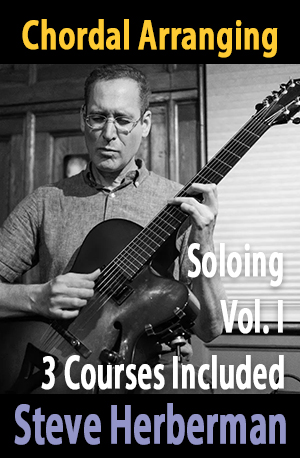Description
Class Contents Includes:
Swing and Big Band Chordal Riffs and Shout Choruses Class Content | Steve Herberman
Wes Montgomery and Kenny Burrell are two guitarists that loved to imitate a horn section with chordal riff figures. Wes used them in his solos and while he comped, even while a pianist was comping along to a soloist. Often overlooked by guitarists, riff figures are an important part of jazz history rooted in the blues, making the music swing hard. So much of Wes Montgomery’s style comes from riffs in octaves and chords sometimes straight from big bands like Basie and Hampton. In this Master Class I’ll go over many of these swinging riff figures and shout choruses and adapt them for guitar.
These are deceptive animals in that they sound easy but are often very hard to negotiate in a chordal style. For example, many figures are quite syncopated and the chord changes occur in what seem like unusual places.
Many times call and response type of motifs are employed to create very interesting solos and comping, with good use of space. This is important work for the jazz guitarist that often gets ignored. For the guitarist who is looking to improve his or her time feel and play compelling chordal motifs created by the swing masters, this class is for you!
View clips from this class
| Swing and Big Band Chordal Riffs and Shout Choruses | |||
| Swing and Big Band Chordal Riffs and Shout Choruses | 01:28:00 | ||
Chord-Melody 101/201 Class Content | Steve Herberman
Chord-Melody 101/201: Making Great Sounding Arrangements with Block Chords
With TAB and standard notation.
You already know a handful of cool sounding voicings but chord-melody arrangements may still be tough. Ever listen to Wes Montgomery’s few unaccompanied chord solos and marvel at how beautiful they are in their simplicity yet they sound so incredible? You may recognize every chord shape Wes is playing, (mostly drop 2 and drop 3 inversions) but how did he arrange it to be so musically satisfying? I’ll offer my insight to this important question and others, recorded live so that questions can be asked at anytime during the recording!
Using the tunes “The Days Of Wine and Roses” and Horace Silver’s “Peace” we’ll compare a variety of choruses on my arrangements included in the class materials (in TAB and/or chord diagram form as well as standard notation.) We’ll look deeply into arranging chord solos that use common chord forms but incorporate some very important musical devices and theory/harmonic principles. Some of these include phrasing (rubato and tempo), the many types of chord substitution principles; introducing color tones or extensions to common chord shapes, changing chord qualities, approach chords, tritone subs, line clichés, and more. Simple yet effective harmonic devices will be shared, the ones you hear the greats use; stock chordal phrases and the more creative ones, along with the theory behind what makes them work. Often simple chromatic motion within a chord form can go a long way in creating interest when the melody is at rest. At times the music may call for dense chords, or inversely, sustained chords with melody notes played over top. We’ll also examine some simple types of single note fills that can be incorporated into an arrangement. If arranging chord-melody has been slow going, I hope you’ll join me for an insightful look into what makes a simple chord solo work.
| Chord-Melody 101/201 | |||
| Chord-Melody 101/201 | 01:34:00 | ||
Chordal Solo Choruses Class Content | Steve Herberman
(in TAB and standard notation)
The inspiration for this fun and challenging class comes from the exciting chordal solo choruses George Van Eps recorded for the Jump record label with his small group. Those solos were all about motion in any voice at any time!
This advanced-level class deals with arranging solos in a contrapuntal 8th note-based chordal style using fingerstyle or hybrid picking. Through the discussion and demonstration of four written solos, arranging techniques are shown to help you compose and eventually improvise solos in this style. The written solos used in the class are an expansion on the rhythm changes etude used in Steve’s class Applications Of Triad Motion Studies inspired by George Van Eps from Sept. 2006 for mikesmasterclasses. Through 2, 3 and 4 part harmony, with an emphasis on triads, we’ll look at independent moving lines which travel in and out of familiar chord forms in a myriad of combinations. The etudes in this class use the progressions of Groovin’ High, It Could Happen To You, Sunny Side Of The Street and All God’s Chillun Got Rhythm. A bar by bar analysis of the techniques are included in the written materials and are expanded in the video. Some of the concepts and techniques demonstrated are: Rootless voicings, minor line clichés, inner line motion, imitation in alternate voices, reharmonizations and substitutions, chromatic lines, and triads up through 13th chords. The aim of the class is to help the musician see how this particular chordal style works and to get some of the language and finger mechanics under the fingers to use in a personal way.
This in-depth 90 minute class comes with 20 pages of written material with TAB included and is
arranged for the standard-tuned 6 string guitar.
View a clip from Steve’s class
| Chordal Solo Choruses | |||
| Chordal Solo Choruses | 01:30:00 | ||



Reviews
There are no reviews yet.